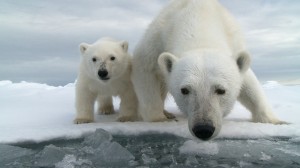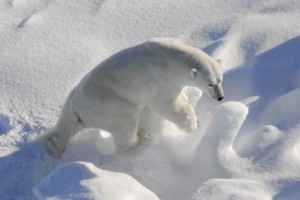If you want to have some fun seeing firsthand how the polar bears are faring in their native Arctic habitat, keep an eye out for a new wildlife documentary called “Polar Bear: Spy on the Ice” from Director John Downer and the BBC. The film recently aired in the U.K. and is scheduled to show on the Animal Planet and Discovery channels in the U.S. later this year.
Downer uses a set of special robotic spy cams with names like “Iceberg Cam” and “Snowball Cam” to get up close and personal with his large, furry Arctic subjects. Designed to blend in with the natural Arctic environment, the camouflaged cams look like the latest gadgets from Q’s lab for the next Bond flick. In one scene, a floating cam wanders by for a nose-level view of a lounging mother bear and her cub. In another entertaining spot below, a curious bear balances his two front paws on a cam that holds up surprisingly well for a time, considering polar bears, the world’s largest terrestrial carnivores, can weigh in at up to three quarters of a ton or 1,500 pounds.
If you’ve ever noticed that a polar bear has big paws, those large mits help them distribute all that weight more evenly and gently across snow and thin ice.
Climate Change and Biodiversity
Polar bears are just one of many species affected by poaching, climate change, and other threats to Arctic biodiversity. According to a report by the Arctic Council/CAFF (Conservation of Arctic Flora and Fauna) titled, “Arctic Biodiversity Trends – 2010: Selected Indicators of Change,” 8 out of 12 sub-populations of polar bears with data are in decline. While human harvesting appears to be the primary culprit, climate exchange is suspected to be another factor.
An estimated population of 20,000 to 25,000 polar bears lives off of the ice-covered Arctic waters and sea ice. Polar bears depend on large surface areas of sturdy sea ice to hunt, travel, mate, and breed. In turn, other species farther down the Arctic food chain like foxes and gulls rely on the leftovers from polar bears’ hunting expeditions for their own survival. According to the Arctic Council/CAFF report, “changes in sea-ice cover and in the patterns of freeze-up and break-up could significantly influence the population ecology of polar bears.”
The report goes on to conclude:
“ . . . if climate warming and the reduction of sea-ice in the Arctic continue as projected by the Intergovernmental Panel on Climate Change (IPCC), it will have profound negative effects on the ability of polar bear subpopulations to sustain themselves, particularly those at the southern parts of their range. Continued climate change will increase the vulnerability and risk to the welfare of all polar bears, and population and habitat modeling have projected substantial future declines in the distribution and abundance of polar bears. This is the single most critical conservation concern for polar bears.”
Environmental Organizations and Protection
To learn more about some of the good work that is being done to protect the polar bears and Artic ecosystem, check out these links to leading environmental organizations and their related Arctic conservation efforts: Conservation International, World Wildlife Fund (WWF).
Related articles:
Cambodia Biodiversity Find – Carnivorous Plant
Biodiversity Saves Lives and Livelihoods



